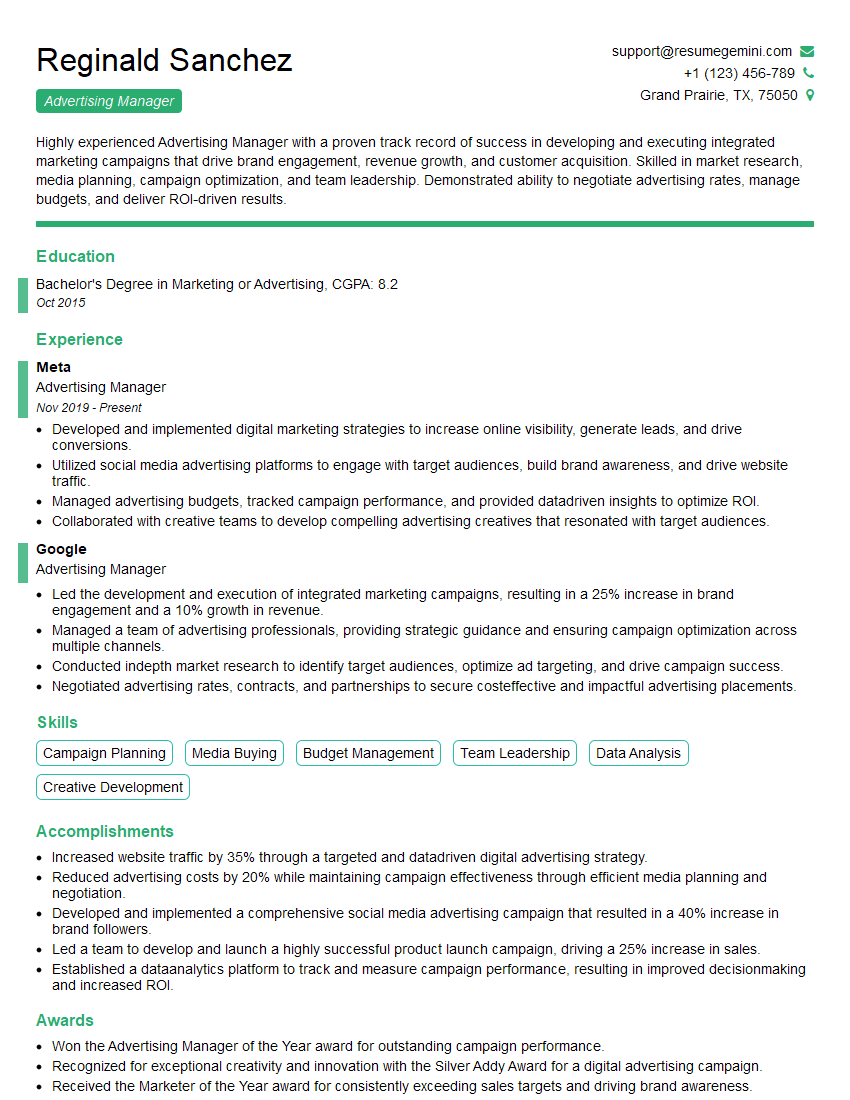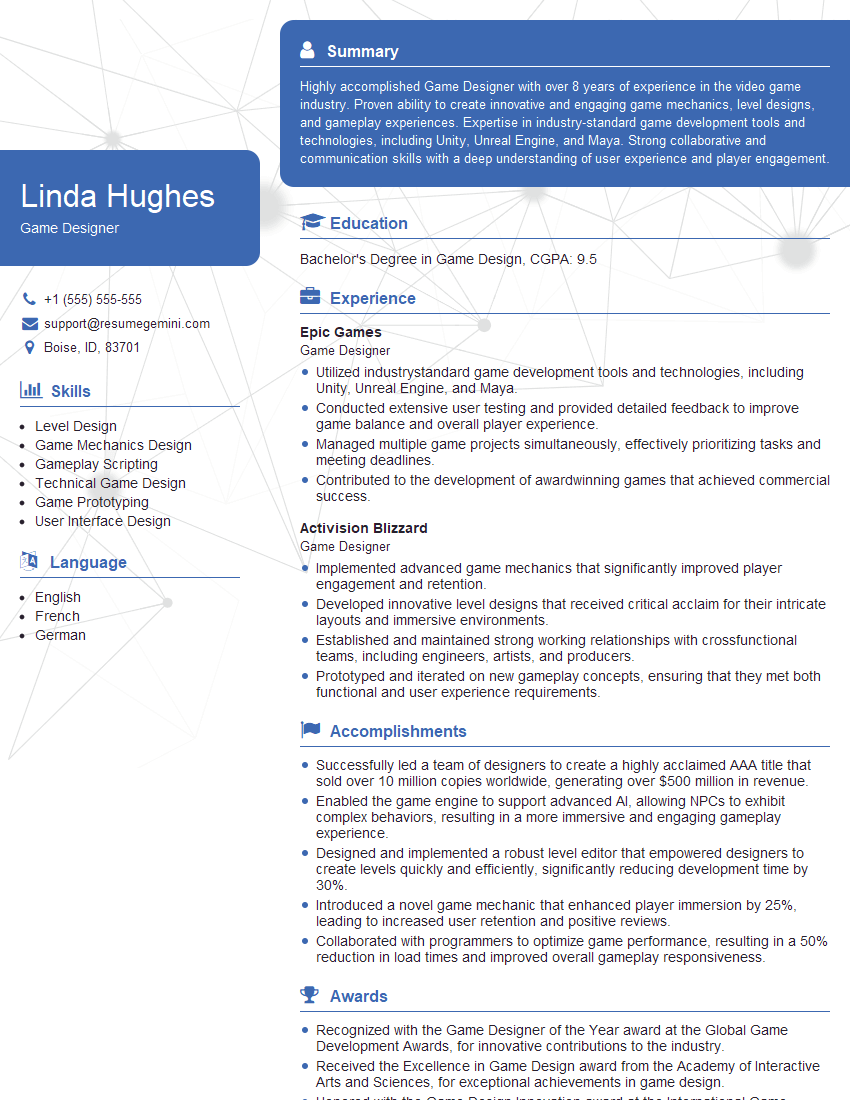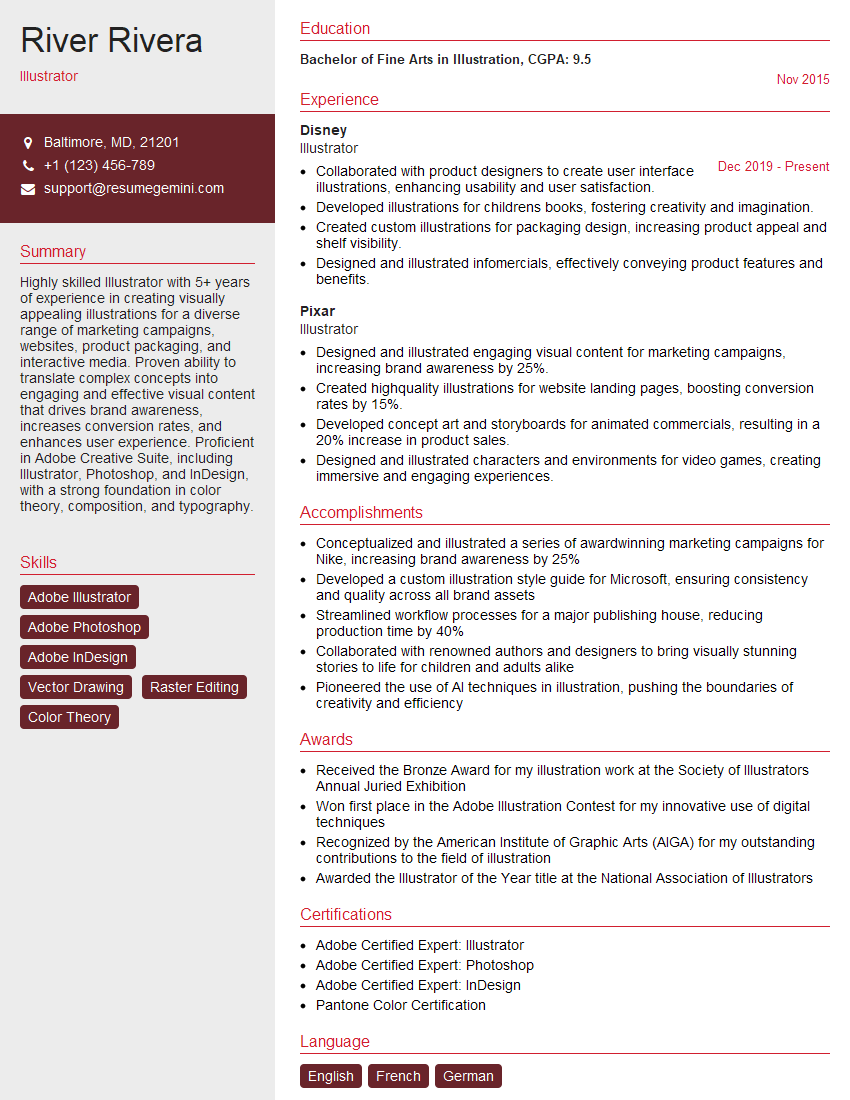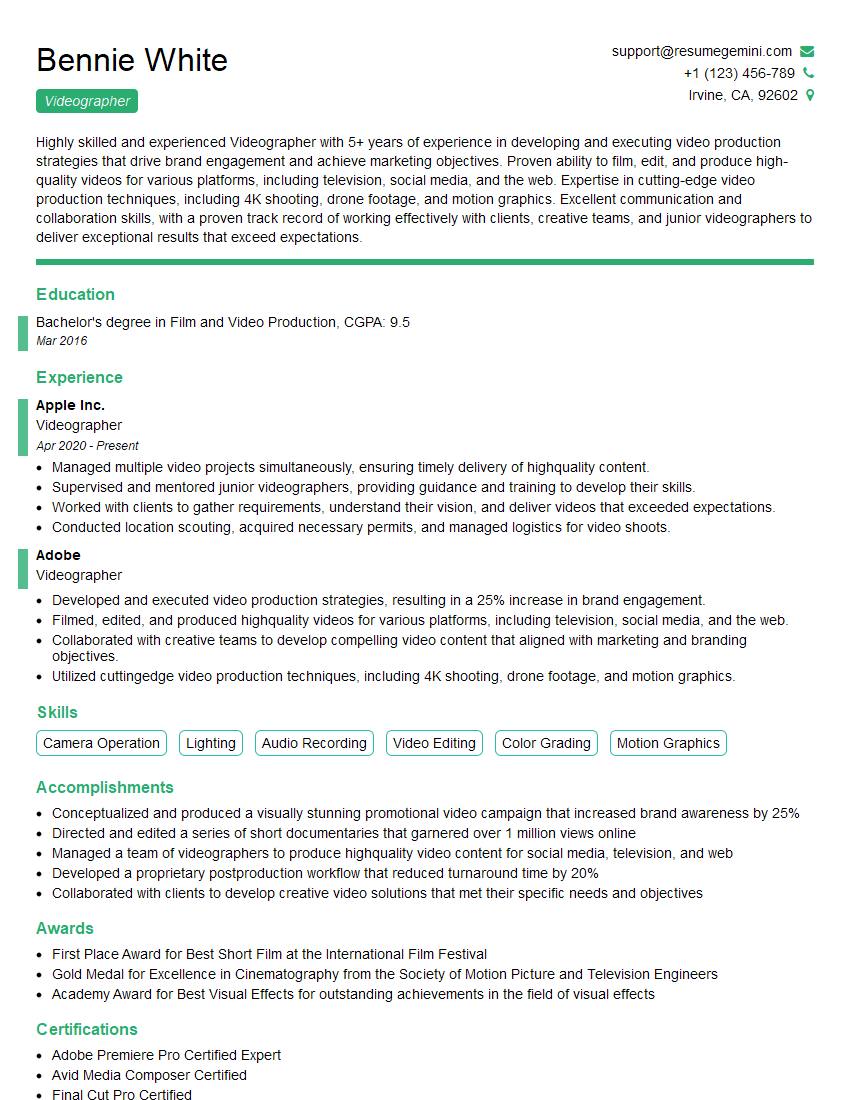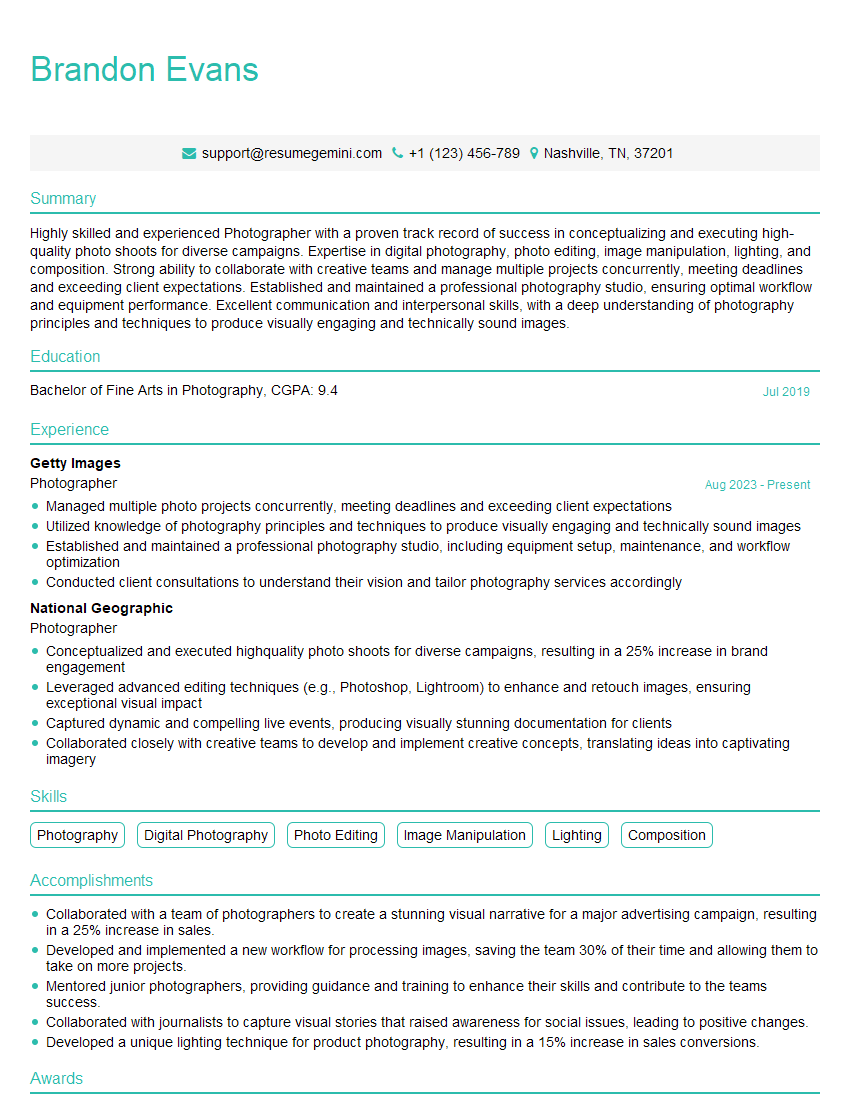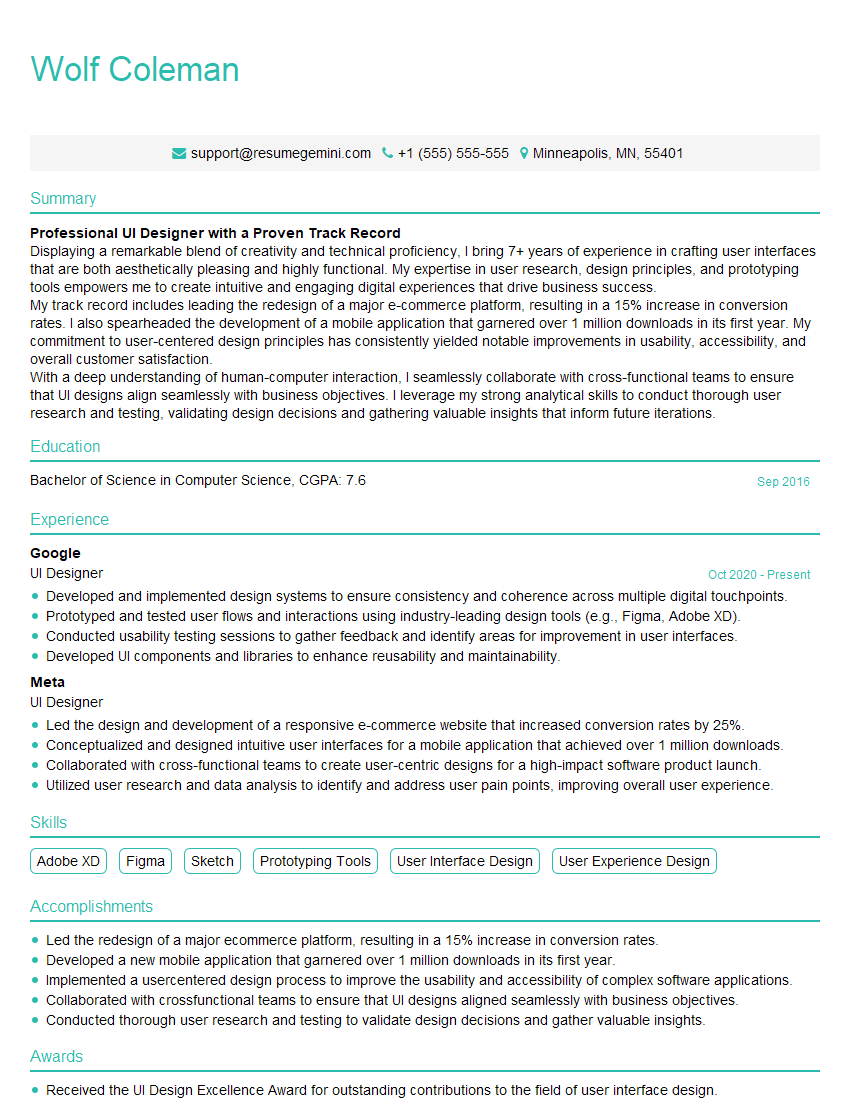Cracking a skill-specific interview, like one for Ability to develop and execute creative concepts, requires understanding the nuances of the role. In this blog, we present the questions you’re most likely to encounter, along with insights into how to answer them effectively. Let’s ensure you’re ready to make a strong impression.
Questions Asked in Ability to develop and execute creative concepts Interview
Q 1. Describe your process for brainstorming creative concepts.
My brainstorming process is a multi-stage approach designed to foster both divergent and convergent thinking. It begins with a deep dive into the brief, understanding the client’s objectives, target audience, and key message. I then employ various techniques:
- Mind Mapping: Starting with a central idea, I branch out to related concepts, exploring various avenues simultaneously.
- SCAMPER: This checklist prompts me to consider Substitute, Combine, Adapt, Modify, Put to other uses, Eliminate, and Reverse elements of the existing ideas or the problem itself.
- Reverse Brainstorming: Instead of focusing on solutions, I brainstorm all the things that *could* go wrong, and then use that to identify how to prevent those issues and build resilience into the concept.
- Mood Boards: Visual brainstorming helps me capture feelings and aesthetics, aligning the visual language with the desired message.
Finally, I prioritize and refine the generated ideas, selecting the most promising concepts for further development. This iterative process ensures I explore a wide range of possibilities before narrowing down to the most effective solutions.
Q 2. How do you translate abstract ideas into tangible creative solutions?
Translating abstract ideas into tangible solutions requires a structured approach. I start by breaking down the abstract concept into its core components. For instance, if the concept is ’empowering women,’ I would dissect it into sub-themes like independence, confidence, and community. Then, I use these components to build a visual or textual narrative. This could involve creating mood boards, storyboards, or sketching initial design concepts. For example, for an advertising campaign, this might translate to choosing specific imagery, colors, and typography that evoke feelings of empowerment. Further refinement then uses concrete methods like wireframing (for digital projects) or creating prototypes (for physical products) to turn the idea into a demonstrable reality.
Crucially, I continuously test and iterate on these tangible representations, seeking feedback and adjusting the solution until it accurately reflects the initial abstract idea while also remaining practical and achievable.
Q 3. Explain a time you had to overcome a creative block.
I once faced a creative block while developing a marketing campaign for a new sustainable product. The initial concepts felt stale and lacked originality. To overcome this, I employed several strategies:
- Stepping Away: I took a break from the project, engaging in activities unrelated to work to clear my mind.
- Seeking Inspiration: I visited museums, art galleries, and explored different online creative communities. The exposure to fresh perspectives triggered new ideas.
- Collaborating with Others: I bounced ideas off colleagues, gaining different viewpoints and injecting new energy into the process.
Ultimately, a simple change of perspective – focusing on the product’s environmental benefits rather than purely on its features – unlocked a fresh and successful campaign centered around a powerful visual metaphor. This experience taught me the importance of actively seeking diverse perspectives and not being afraid to change direction when necessary.
Q 4. How do you ensure your creative concepts align with business objectives?
Aligning creative concepts with business objectives is paramount. From the outset, I ensure a thorough understanding of the business goals, target metrics (e.g., sales increase, brand awareness, lead generation), and the overall marketing strategy. I then translate these goals into specific, measurable, achievable, relevant, and time-bound (SMART) creative objectives. For example, if the business goal is to increase brand awareness by 20%, a corresponding creative objective might be to create a social media campaign achieving 100,000 impressions within a month. Throughout the creative process, I regularly check if the developing concept is still on track to achieve these SMART objectives, making adjustments as needed. This ensures the creative work is not only aesthetically pleasing but also strategically effective.
Q 5. Describe your experience working with cross-functional teams on creative projects.
I thrive in cross-functional team environments. My experience working on various creative projects with marketing, sales, engineering, and product teams has instilled in me the importance of effective communication, collaboration, and compromise. I actively participate in team discussions, ensuring my creative ideas are presented clearly and are thoroughly understood by team members from different backgrounds. I also value actively listening to and incorporating feedback from other team members, understanding their perspectives and constraints. This collaborative approach often leads to more robust and innovative solutions that consider diverse viewpoints and perspectives.
For example, on a recent project, collaboration with the engineering team ensured the creative concept was technically feasible and could be implemented successfully.
Q 6. How do you measure the success of a creative campaign or project?
Measuring the success of a creative campaign goes beyond simply looking at aesthetic appeal. My approach is data-driven. I establish Key Performance Indicators (KPIs) aligned with the initial business objectives. These KPIs could include:
- Website traffic and engagement: Tracking website visits, bounce rate, time on site, and conversion rates.
- Social media engagement: Measuring likes, shares, comments, and reach.
- Sales data: Analyzing sales figures to determine the impact of the campaign on revenue.
- Brand awareness surveys: Gathering feedback to assess changes in brand perception.
By tracking these KPIs, I can quantitatively assess the effectiveness of the campaign and identify areas for improvement. I also use qualitative data such as user feedback and competitor analysis to gain a more comprehensive understanding of campaign success.
Q 7. How do you handle feedback on your creative work, both positive and negative?
I view feedback as an invaluable opportunity for growth and improvement. I approach both positive and negative feedback with an open mind. Positive feedback helps validate the effectiveness of my creative approach, while constructive criticism provides insights for future projects. I listen carefully to feedback, asking clarifying questions to ensure I fully understand the points being raised. I then consider the feedback within the context of the project goals and determine how best to incorporate the suggestions. Even if I disagree with a particular piece of feedback, I will always carefully consider the reasoning behind it. My goal is not just to create visually appealing work, but to create work that effectively meets the needs and objectives of the client and the business.
Q 8. What software or tools are you proficient in for creative concept development?
My creative concept development workflow relies heavily on a suite of digital tools. I’m proficient in industry-standard software like Adobe Creative Suite (Photoshop, Illustrator, InDesign), Figma for UI/UX design, and Blender for 3D modeling and animation. Beyond these, I utilize mind-mapping tools like XMind to brainstorm and organize ideas visually. For prototyping and quick mockups, I leverage tools like Balsamiq. The specific tool I choose depends on the project’s needs; for instance, if we’re designing a print advertisement, Adobe InDesign is ideal, whereas a mobile app would necessitate Figma. My proficiency extends to understanding the strengths and limitations of each tool, ensuring the most efficient and effective workflow.
For example, when designing a marketing campaign, I might use XMind to initially brainstorm various campaign concepts. Then, I’d use Photoshop to create visual mockups of the ads, and InDesign to design print materials. Finally, I might use Figma to create wireframes and mockups for any digital elements of the campaign.
Q 9. Describe a time you had to adapt a creative concept based on new information or constraints.
During a project developing a promotional video for a new sustainable clothing line, we initially conceptualized a vibrant, fast-paced video showcasing models in various locations. However, after receiving feedback from the client, highlighting budget constraints and concerns about the environmental impact of extensive filming, we had to adapt. We pivoted to a more minimalist approach, focusing on close-up shots of the clothing’s texture and details, interspersed with shots of natural landscapes. We utilized existing stock footage and supplemented it with creatively lit shots filmed in a studio, resulting in a cost-effective and environmentally conscious video that still effectively conveyed the brand’s message. This experience reinforced the importance of flexibility and creative problem-solving when faced with unexpected limitations.
Q 10. How do you prioritize different creative ideas and concepts?
Prioritizing creative ideas involves a multi-faceted approach. I start by evaluating each concept’s feasibility, considering factors like budget, time constraints, and available resources. Next, I assess its alignment with the project’s overall goals and target audience. Finally, I consider the potential impact and return on investment (ROI). I often use a scoring system, assigning points to each criterion to objectively compare different ideas. The most effective concepts are often those that balance creative innovation with practical considerations. Sometimes, a seemingly less innovative idea can be more impactful due to its practicality or feasibility.
For instance, if faced with two concepts for an advertising campaign, one being a high-budget, visually stunning video and another a more modest but easily shareable social media campaign, I would weigh the pros and cons of each. If the budget is tight and the goal is quick engagement, the social media campaign might be prioritized, despite the video’s superior visual appeal.
Q 11. How do you stay up-to-date with current trends and best practices in your creative field?
Staying current in the creative field is an ongoing process. I subscribe to industry newsletters and blogs, such as those from AIGA and Creative Bloq. I actively follow leading designers and creatives on social media platforms like Behance and Instagram, observing their work and gaining inspiration. Attending industry conferences and workshops offers invaluable networking opportunities and insights into the latest trends and techniques. Further, I actively participate in online communities and forums to engage in discussions and learn from other professionals. Continuously learning and adapting to emerging trends is vital for staying ahead in this dynamic field.
Q 12. Describe your approach to managing multiple creative projects simultaneously.
Managing multiple creative projects requires a structured approach. I employ project management tools like Asana or Trello to track tasks, deadlines, and progress across all projects. I prioritize tasks based on urgency and importance, using methods like the Eisenhower Matrix (urgent/important). I break down large projects into smaller, manageable tasks, making it easier to track progress and allocate time effectively. Regular communication with clients and team members is crucial to ensure everyone is on the same page and to proactively address any potential roadblocks. Effective time management and organization are key to successfully juggling multiple projects without compromising quality.
Q 13. How do you handle creative differences of opinion within a team?
Creative differences are inevitable, and I view them as opportunities for growth and innovation. My approach emphasizes open communication and respectful dialogue. I encourage team members to articulate their perspectives clearly, providing a safe space for constructive criticism. I facilitate discussions that focus on the merits of each idea rather than personal opinions. Ultimately, the goal is to find a solution that aligns with the project’s objectives and incorporates the best aspects of each proposed concept. Sometimes, compromise is necessary, but often, synthesis of different viewpoints leads to surprisingly innovative outcomes.
Q 14. Explain your understanding of the design thinking process.
Design thinking is a human-centered problem-solving approach that prioritizes empathy and iterative development. It involves five key phases: Empathize (understand the user’s needs), Define (clearly articulate the problem), Ideate (generate creative solutions), Prototype (build and test solutions), and Test (evaluate and iterate based on user feedback). This iterative process allows for flexibility and adaptation, ensuring the final solution effectively addresses the identified problem while satisfying user needs. It’s a cyclical process, meaning that feedback from the testing phase often leads back to earlier stages for refinement. I use design thinking extensively in my work to ensure that creative solutions are not only aesthetically pleasing but also functional and user-friendly.
Q 15. How do you use data and analytics to inform your creative decisions?
Data and analytics are crucial for grounding creative concepts in reality. Instead of relying solely on intuition, I use data to understand audience behavior, preferences, and trends. This ensures the creative work is not only aesthetically pleasing but also effective in achieving its intended goals.
For instance, before designing a marketing campaign, I’d analyze website analytics to understand user demographics, popular content, and conversion rates. This data informs design choices – from the visuals and messaging to the call to action. Similarly, A/B testing different creative versions allows me to measure the impact of various design elements and optimize for maximum engagement. I use tools like Google Analytics, social media analytics dashboards, and even custom data visualizations to gain actionable insights.
Imagine designing a website for a new coffee shop. Instead of just guessing what kind of imagery or copy would appeal to customers, I’d analyze competitor websites, look at local demographic data, and perhaps even conduct a small survey to understand customer preferences. This data-driven approach allows me to create a more targeted and effective design.
Career Expert Tips:
- Ace those interviews! Prepare effectively by reviewing the Top 50 Most Common Interview Questions on ResumeGemini.
- Navigate your job search with confidence! Explore a wide range of Career Tips on ResumeGemini. Learn about common challenges and recommendations to overcome them.
- Craft the perfect resume! Master the Art of Resume Writing with ResumeGemini’s guide. Showcase your unique qualifications and achievements effectively.
- Don’t miss out on holiday savings! Build your dream resume with ResumeGemini’s ATS optimized templates.
Q 16. Describe a time you had to present a creative concept to a client or stakeholder.
Recently, I presented a creative concept for a new mobile app to a team of investors. The app aimed to simplify expense tracking for freelancers. My presentation wasn’t just about visuals; it focused on the user journey and the app’s overall value proposition. I started with the problem – the difficulty freelancers face in managing their finances – then presented the solution – our intuitive and visually appealing app.
I showcased user flow diagrams, wireframes, and mockups to illustrate the app’s functionality and user experience. I used data points from competitor analysis and market research to justify the app’s potential. Crucially, I presented several alternative design directions and explained the rationale behind my chosen approach, showcasing my ability to consider multiple solutions and justify my creative decisions. The visual presentation was clear, concise and visually engaging, incorporating animations and interactive elements where appropriate. The investors were impressed by the clear articulation of the concept and the supporting data, which led to securing funding.
Q 17. How do you incorporate user feedback into the development of your creative concepts?
User feedback is invaluable in refining creative concepts. I actively solicit feedback throughout the design process, using various methods. This could involve usability testing, surveys, focus groups, or simply gathering comments from social media engagement.
For example, during the development of a website, I might conduct usability testing with a representative sample of target users. I’d observe how they interact with the site, identify pain points, and gather their feedback on the design’s overall effectiveness and user-friendliness. This feedback is then analyzed and incorporated into design iterations, ensuring the final product aligns with user needs and expectations. It’s a continuous cycle of iteration and improvement, prioritizing the user experience above all else.
Q 18. How do you ensure the visual consistency of your creative work across different platforms?
Maintaining visual consistency across platforms is vital for brand recognition and user experience. This is achieved by developing a comprehensive brand style guide. This guide outlines the brand’s visual identity, including its logo, color palette, typography, imagery style, and overall design language.
I ensure that this style guide is rigorously followed across all platforms – website, social media, print materials, etc. Using design system tools and components, I maintain uniformity and efficiency. Tools like Figma or Adobe XD, coupled with a well-defined component library, help streamline the design process and ensure consistency. For example, every button, heading, and image would adhere to the pre-defined style guide, ensuring a cohesive brand experience regardless of the platform.
Q 19. Explain your approach to prototyping and iterating on creative concepts.
My approach to prototyping and iteration is iterative and user-centric. I start with low-fidelity prototypes – sketches, wireframes – to quickly explore ideas and get initial feedback. As the design matures, I move towards high-fidelity prototypes, incorporating visual design and interaction details. These prototypes are then tested with users, and their feedback informs further iterations.
This process is not linear; it involves cycles of prototyping, testing, and refinement. I often use tools like Figma or Adobe XD to create interactive prototypes, allowing users to experience the design as it would be in a real-world setting. This iterative process ensures that the final design is well-tested, user-friendly, and meets the project’s objectives.
Q 20. How do you balance creativity with practicality in your work?
Balancing creativity and practicality is essential for effective design. While creative ideas are important, they must be grounded in reality and feasibility. This requires understanding project constraints – budget, timeline, technical limitations – and adapting the creative vision accordingly.
For instance, a highly creative, visually complex design might be impractical for a low-budget project with tight deadlines. In such a scenario, I would prioritize functionality and simplicity, focusing on achieving the core objectives without unnecessary visual complexity. This requires prioritizing features, simplifying the design, and focusing on the most impactful elements. It’s a matter of finding the sweet spot between creative ambition and practical constraints.
Q 21. Describe a time you used an unconventional approach to solve a creative problem.
I once faced a challenge of creating a visually engaging marketing campaign for a sustainable fashion brand with a limited budget. Traditional approaches were too expensive. Instead of using professional photography, I collaborated with local artists and photographers to create unique illustrations and stylized images. This not only saved costs but also resulted in a distinct and memorable visual identity that aligned perfectly with the brand’s values.
This unconventional approach also resonated well with the target audience, generating significant social media engagement and ultimately proving highly successful in terms of brand awareness and conversions. It highlighted that creativity can often be found in unexpected places and resourcefulness can lead to innovative solutions.
Q 22. How do you handle unexpected challenges or setbacks in a creative project?
Unexpected challenges are inevitable in creative projects. My approach is a three-pronged strategy focusing on adaptability, problem-solving, and communication. First, I embrace a flexible mindset, viewing setbacks not as failures but as opportunities for learning and refinement. For example, during a recent campaign, our initial video concept was deemed too lengthy by the client. Instead of resisting, we collaborated, identifying key messaging points and creating shorter, more impactful video segments tailored to different platforms.
Secondly, I employ a systematic problem-solving process. I break down the challenge into smaller, manageable components, brainstorming various solutions with my team. We analyze the root cause, explore alternative approaches, and evaluate potential risks and benefits before selecting the most effective solution. Finally, open and honest communication is paramount. I ensure all stakeholders are informed of any challenges and collaboratively explore solutions, maintaining transparency throughout the process.
Q 23. How do you delegate tasks effectively within a creative team?
Effective delegation in a creative team hinges on understanding individual strengths and matching tasks to those abilities. I begin by clearly defining roles and responsibilities, outlining specific objectives, deadlines, and expected outcomes for each task. I then assess my team members’ skills and experience, assigning tasks that align with their expertise and provide opportunities for growth. For instance, a junior designer might be assigned a component of a larger project, allowing them to learn from more senior team members while contributing meaningfully.
Beyond task assignment, open communication and regular check-ins are crucial. I encourage feedback, provide support and mentorship, and foster a collaborative environment where team members can freely express their ideas and concerns. This ensures projects progress smoothly and fosters a sense of shared ownership and accomplishment.
Q 24. Describe a time you had to defend a creative decision.
In a previous project, I proposed a minimalist design concept for a website, which deviated significantly from the client’s initial, more cluttered vision. My rationale was that a cleaner design would enhance user experience and brand clarity. The client initially expressed skepticism, worried about the minimalistic approach not conveying enough information.
To defend my decision, I presented data-driven evidence, showcasing studies on user engagement and conversion rates with minimalist designs. I also created mockups demonstrating how we could effectively communicate key information within the simpler design. Furthermore, I showcased successful examples of minimalist websites in similar industries. By demonstrating the strategic thinking and evidence behind my creative choice, I was able to secure the client’s buy-in, resulting in a more impactful and successful website.
Q 25. How do you maintain originality and innovation in your creative work?
Maintaining originality and innovation requires a multi-faceted approach. First, I actively seek inspiration from diverse sources. This includes observing everyday life, exploring different cultures, engaging with art and design outside my field, and following industry trends. Secondly, I cultivate a mindset of continuous learning. I regularly explore new tools, techniques, and technologies, constantly challenging my creative processes.
Another key element is embracing experimentation. I encourage “fail fast, learn fast” experimentation within a controlled environment to test new ideas. This allows for the discovery of unexpected solutions and prevents getting stuck in creative ruts. Finally, I believe in fostering a culture of collaboration and open dialogue within my teams, where diverse perspectives are valued and contribute to innovative solutions. The interplay of ideas often leads to unexpected breakthroughs.
Q 26. How do you ensure your creative concepts are both innovative and practical?
Balancing innovation and practicality requires a keen awareness of both the creative vision and the business constraints. The key is to ensure that innovative concepts are not only exciting but also feasible and effective within the given parameters. I begin by clearly defining project goals, objectives, and target audience. This helps ground the creative process and ensures that innovative ideas align with the overall strategic direction.
Next, I utilize a phased approach, starting with brainstorming and concept generation, which allows for a range of ideas to be explored. Following this, a rigorous evaluation phase ensues, where we analyze the feasibility, cost-effectiveness, and potential impact of each concept. We consider factors such as budget, technical limitations, and timeline constraints. Only ideas that are both creative and realistic are taken forward. This iterative process ensures that the final solution is not only innovative but also practically achievable and aligned with business objectives.
Q 27. How do you measure the ROI of your creative projects?
Measuring the ROI of creative projects requires a nuanced approach beyond simple metrics. While traditional metrics like website traffic or sales figures are useful, they don’t always capture the full impact of creative campaigns. I approach ROI measurement through a multi-faceted approach, establishing clear KPIs (Key Performance Indicators) before the project commences. These KPIs depend on project objectives and may include brand awareness, lead generation, customer engagement, or sales conversions.
For instance, for a branding campaign, we might measure changes in brand sentiment through social media monitoring and customer surveys. For a lead generation campaign, we would track conversion rates and cost per lead. I also use analytics tools to monitor website traffic, engagement, and conversion rates, correlating these to specific creative assets. By comprehensively tracking and analyzing these KPIs both before and after the campaign, I can accurately assess the return on investment of creative projects and inform future strategies.
Q 28. Describe your experience with A/B testing creative concepts.
A/B testing is a crucial part of my creative workflow, enabling data-driven optimization of campaigns and designs. I frequently employ A/B testing for elements like website layouts, headlines, calls-to-action, and visual design components. The process typically involves creating two or more versions of a design or campaign element, each with a slightly different variation. These variations are then presented to different segments of the target audience simultaneously.
For example, we might A/B test two different headlines for an email campaign, tracking open and click-through rates to determine which headline performs better. We use analytics platforms to track key metrics and collect data on user behavior. This data provides clear evidence of which creative element resonates more effectively with the target audience, guiding future creative decisions. The iterative nature of A/B testing allows for continuous improvement and optimization of creative concepts.
Key Topics to Learn for Ability to Develop and Execute Creative Concepts Interview
- Idea Generation & Brainstorming: Understanding various brainstorming techniques (e.g., mind mapping, SCAMPER), effectively leveraging diverse perspectives, and overcoming creative blocks.
- Concept Development & Refinement: Transforming initial ideas into concrete concepts, iteratively refining them based on feedback and analysis, and presenting compelling narratives.
- Creative Problem-Solving: Applying creative thinking to solve complex problems, identifying innovative solutions, and demonstrating adaptability in the face of challenges.
- Visual Communication & Storytelling: Effectively communicating concepts visually through sketches, mockups, or presentations; crafting compelling narratives to engage target audiences.
- Collaboration & Teamwork: Working effectively within a team to develop and execute creative concepts, providing constructive feedback, and contributing positively to the collaborative process.
- Execution & Project Management: Developing realistic timelines and budgets, managing resources effectively, and ensuring timely and successful project delivery.
- Analytical & Critical Thinking: Assessing the effectiveness of creative concepts, analyzing data to inform decisions, and refining strategies for optimal results.
- Understanding Target Audience: Conducting thorough audience research to tailor creative concepts to specific demographics, needs, and preferences.
Next Steps
Mastering the ability to develop and execute creative concepts is crucial for career advancement in today’s dynamic market. It demonstrates valuable problem-solving skills, innovation, and the capacity to contribute significantly to organizational success. To maximize your job prospects, creating an ATS-friendly resume is essential. ResumeGemini is a trusted resource that can help you build a professional and impactful resume, highlighting your creative capabilities. Examples of resumes tailored to showcasing your “Ability to develop and execute creative concepts” are available within ResumeGemini to further guide your preparation.
Explore more articles
Users Rating of Our Blogs
Share Your Experience
We value your feedback! Please rate our content and share your thoughts (optional).
What Readers Say About Our Blog
Hello,
We found issues with your domain’s email setup that may be sending your messages to spam or blocking them completely. InboxShield Mini shows you how to fix it in minutes — no tech skills required.
Scan your domain now for details: https://inboxshield-mini.com/
— Adam @ InboxShield Mini
Reply STOP to unsubscribe
Hi, are you owner of interviewgemini.com? What if I told you I could help you find extra time in your schedule, reconnect with leads you didn’t even realize you missed, and bring in more “I want to work with you” conversations, without increasing your ad spend or hiring a full-time employee?
All with a flexible, budget-friendly service that could easily pay for itself. Sounds good?
Would it be nice to jump on a quick 10-minute call so I can show you exactly how we make this work?
Best,
Hapei
Marketing Director
Hey, I know you’re the owner of interviewgemini.com. I’ll be quick.
Fundraising for your business is tough and time-consuming. We make it easier by guaranteeing two private investor meetings each month, for six months. No demos, no pitch events – just direct introductions to active investors matched to your startup.
If youR17;re raising, this could help you build real momentum. Want me to send more info?
Hi, I represent an SEO company that specialises in getting you AI citations and higher rankings on Google. I’d like to offer you a 100% free SEO audit for your website. Would you be interested?
Hi, I represent an SEO company that specialises in getting you AI citations and higher rankings on Google. I’d like to offer you a 100% free SEO audit for your website. Would you be interested?
good
